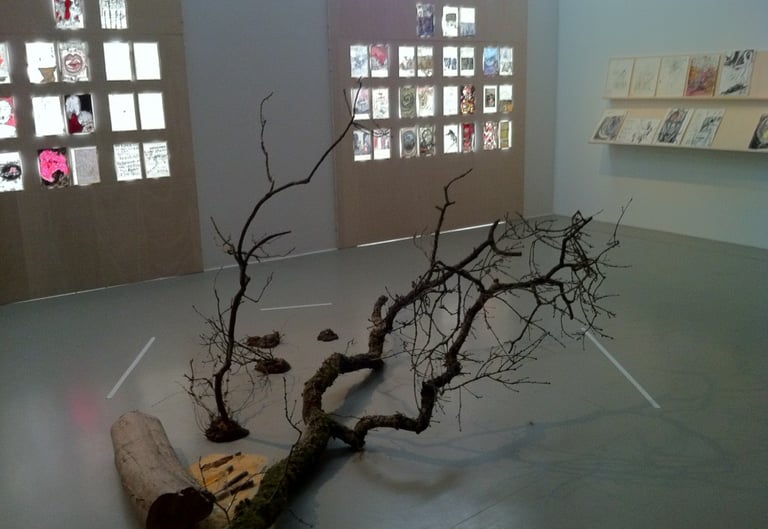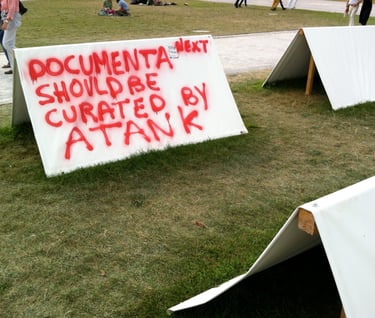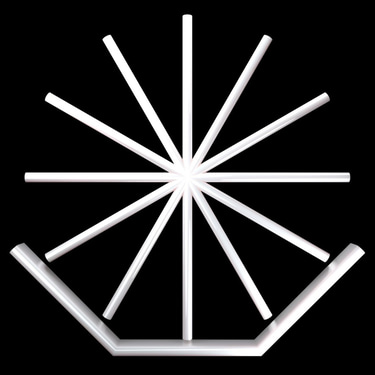13 going on ’13: Remembering dOCUMENTA(13)
Evan Moffitt
1/22/2013


The apocalypse came and went with tremendous anticlimax. With 2012 ending, the world awaited its own end, agitated by deepening fears of economic and earthly disaster. 13 is as reviled a number in the majority of Western culture — carrying an ominous stigma since the Friday 13, 1307 eradication of the powerful Knights of Templar order. And as December 31 ticked by, many were left wondering if the new year would really be luckier than the last.x
This past September, a semester abroad in Berlin brought me to the provincial German town of Kassel in time for contemporary art’s most famous exhibition extravaganza, dOCUMENTA. This summer inaugurated dOCUMENTA(13), the thirteenth cycle since it began in Kassel, a quiet city that has blossomed with galleries in the last thirty years of the festival’s run. The buzz behind the show was almost as large as the festival’s three volume, 767-page catalogue. The work of 200 artists from around the world was exhibited over 100 days of central Germany’s temperate summer; 100 of the displayed pieces were created specifically for dOCUMENTA itself. The works were of every available medium—paintings, sculptures, photographs, videos, installations, and computer art—as well as organic materials. Installations at Kassel’s Ottoneum and Orangerie, especially American artist Claire Pentecost’s gold barrens of pressed soil, pressed poignantly on environmental issues, connecting well to the exhibition’s central theme of “Man und Umwelt” (Mankind and the Environment).
Lucky #13 followed on the heels of the global financial crisis and augurs of a Euro-collapse. The green lawn before Kassel’s Fredericianum was blanketed in tents housing participants from an upstart “Occupy dOCUMENTA,” bearing signs suggesting “dOCUMENTA should be curated by a tank.” And yet, the exposition’s curators had long before chosen the environment as the festival’s central theme. Perhaps a result of poor timing, the thematic choice reflected little of the contemporary concerns of many artists represented, most of whom reflected on housing crises, unemployment, and increasing globalization plaguing the third world in their work.


Far from a failure, dOCUMENTA(13)’s success lay with those artists who strayed from the topical focus of the festival. The illuminated watercolor diagrams of Egyptian artist Anna Boghiguian used Hegel’s dialectic to observe economic divisions between Western Europe and the former Eastern bloc. They glowed somberly next to a gripping series of gouaches by German-Jewish Berliner Charlotte Solomon, titled Leben? Oder Theater? (Life? Or Theater?). Solomon’s series, follows the story of a Jewish girl’s painful persecution at Nazi hands. The work was completed while the artist was five months pregnant, and just months before she was killed in Auschwitz. Her much older work nonetheless complimented recent submissions by veteran artist Llyn Foulkes. Some of Foulkes’ deeply textured sculptural canvases, like his 2012, The Awakening have been in process for nearly fifteen years. Foulkes’ work will travel to the Hammer Museum next month, where he will also perform with “The Machine”, a drum kit festooned in car horns which he plays while singing hymns of capitalist society’s commercial self-immolation.
dOCUMENTA is long over, though 2013 is far from it. Let us hope this year is as ill-defined by its date as the festival’s 13th installment was by its theme.
